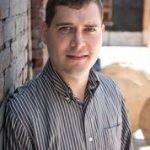- Read part 1: “The Grinding Halt“
- Read part 2: “Loving a City in Lockdown“
Meanwhile, the virus continued to ravage our city. A family that we delivered groceries to lost someone to COVID (it took over a month to bury him). A Baptist pastor in Brooklyn lost nearly 30 members in a month. Multiple members of our church contracted COVID, but thankfully they all pulled through (the average age in our church is under 40, so we are less at risk).
Finally, the curve began to bend. Hospitalizations decreased. The sun seemed like it was shining again. Then, near the end of our 79-day lockdown, we all watched the news in horror at George Floyd’s murder.
These days were surreal, and the nights were even worse.
New York City erupted at this gross instance of injustice. Violent crime was already on the rise (at one point, nearly 25% of the NYPD was out due to COVID; as a result, crime skyrocketed). People began to protest. Others turned violent and began to loot. I led a handful of church members to join with hundreds of other Christians to march through downtown Brooklyn in a peaceful, “prayerful protest.”
I still remember standing nervously in the socially-distanced crowd of clergy who gathered prior to the march. We were told by the organizer that the NYPD had just asked us to call off the event, because they were fearful that Antifa might try and infiltrate our group in order to stir up violence. But it was too late to call it off. We were marching, nearly 1,000 strong. I called my wife, told her I loved her, and marched alongside fellow pastors and members of our church. Through our masks, we prayed, we sang, we cried. After the march, we hurried home. That was the first night of our citywide 8PM curfew. None of us wanted to be out after 8PM.
These days were surreal, and the nights were even worse. The eerie wail of ambulance sirens repeatedly punctuated the night. Out-of-state networks funneled professional grade fireworks into the city, terrorizing an already shell-shocked populace. For three nights, our youngest child could barely sleep, because of fireworks on our block (firefighters who man the fire station across the street from our apartment were even caught setting off fireworks).
We were thrilled when our shelter-in-place order was lifted, although our congregation could not immediately resume churchwide gatherings. Prior to COVID, we had rented space from a public school. Now, schools were closed due to COVID. As we searched for a new church building we adopted a microchurch strategy. We gathered in groups of 10 or fewer people. Some groups met in person, some digitally. Some used a hybrid approach. I wish I could say that our microchurch strategy worked, but it was a difficult and confusing journey that lasted throughout the summer.
We managed to leave the city for a week and spend time in Vermont with my wife’s family. It was just the respite we needed. We returned to New York and had a baby. This was our fourth child, and this experience was unique. God protected us from exposure while we were at the hospital (at one point we even considered a home birth, due to the war-zone type scenes unfolding at New York’s hospitals).
About one third of our congregation is gone now.
The playgrounds reopened and my kids began to play again, like kids are supposed to. They made friends with their neighbors and chased them around the playground (everyone wears masks, of course).
We found a jazz restaurant that was trying to open during the pandemic (unfortunate timing for this small business). We asked to rent space, and after some negotiations, we were granted permission to gather and worship. Other than one outdoor summer service, our regathering in September was our first in-person church service since March. Many of us hadn’t been together since our art event.
It was a joyous moment to regather as reunited members of a family, all survivors of a pandemic. Of course, the service felt different. We wore masks. We kept our distance. We used personalized communion cups instead of the more communal approach that we prefer. Instead of singing, we whispered and raised our hands as we listened to our worship leader sing.
There were a lot of empty chairs. About one third of our congregation is gone now. Most of those absent family members have permanently relocated due to COVID. There’s also a new couple in attendance, people we met through our relief efforts. We soldier on, with decreased numbers, diminished finances, and weary souls. We start an exposition of Hebrews, called Better. We try to remind each other that Jesus is better than what we lost, better than what we have, better than what we will regain when this is all over. Jesus is better.
My friend’s food truck is once again on the go, providing meals to those in need. We partnered to safely serve the essential workers at the school we used to worship in. Every educator got a free hot meal, a mask, sanitizer, gloves, and a gospel booklet. We’re planning more events at other locations. Because, even though our future is uncertain (the first vaccines are being administered today), we have learned that you can’t quarantine hope.




Comments and Pingbacks
2021-01-27 09:35:30
The Grinding Halt | The COVID Chronicles, Part 1 | Intersect
[…] Read part 3: “Erupting and Adapting“ […]